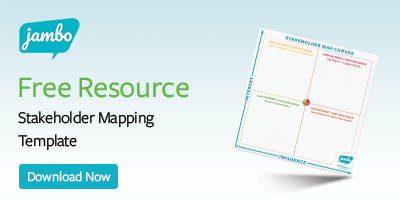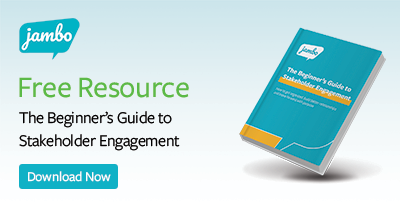
Stakeholder engagement refers to building and maintaining relationships with individuals, groups or communities interested in your organization's activities, decisions, and outcomes. These can include local communities, businesses, landowners, Indigenous communities, governments, NGOs, etc.
Effective stakeholder engagement is essential for several reasons:
- Risk management: Engaging with stakeholders helps you identify potential risks, allowing you to take proactive steps to mitigate them.
- Improved decision-making: By considering diverse perspectives, you can make more informed decisions that are better aligned with your stakeholders' needs and interests.
- Enhanced reputation: Stakeholder engagement demonstrates your commitment to transparency, accountability, and social responsibility, which can improve your organization's reputation and credibility.
- Increased trust and strong relationships: Open communication and stakeholder collaboration can build trust and foster a sense of community, leading to stronger relationships and greater loyalty.
So, how do you get started with stakeholder engagement? Here is our 6-step starter kit for success:
Step 1: Identify your key stakeholders
Begin by creating a comprehensive list of stakeholders who'll be involved in or affected by your project or initiative. This is called stakeholder mapping.
If you're having trouble identifying your stakeholders, our blog, 9 Questions to Help Identify Your Stakeholders, might help.
You now want to rank stakeholders based on their influence, interest, and importance to the project's success. Then, segment stakeholders based on their needs, concerns, and required levels of engagement. This is called stakeholder analysis.
Understanding the unique needs of each stakeholder group allows you to tailor your stakeholder engagement plan to better target specific groups with relevant information. Not all stakeholders need to be engaged in the same way. An important part of the stakeholder analysis process is choosing each stakeholder group's engagement level. The Spectrum of Public Participation, developed by the International Association for Public Participation (IAP2), identifies five different levels of participation: inform, consult, involve, collaborate, and empower. This is a valuable tool to help guide your stakeholder engagement and determine the engagement levels you'll assign to each stakeholder group.
Step 2: Understand stakeholder interests
Once you've identified your stakeholders, research to try to understand their interests and concerns and what will drive their behaviours and attitudes. Look at media articles and social media comments. By assessing your stakeholders, you can tailor your engagement approach (step 3) to address their specific needs and expectations.
To assess stakeholder interests, ask yourself:
- What are their needs and expectations?
- What do they hope to achieve from engaging with your organization?
- What are their goals, objectives, or priorities?
- How might they be impacted by our decisions or actions?
- Are there potential benefits or risks associated with your project or initiative?
- How will stakeholders be affected by the outcome of your decision-making process?
- Are there any potential conflicts of interest?
- Do stakeholders have competing interests or loyalties that could impact their engagement with your organization?
Step 3: Develop a stakeholder engagement plan
A stakeholder engagement plan outlines how you and your team will engage with your stakeholders to achieve positive project outcomes.
Your engagement plan should include:
- Your desired outcomes (the goal)
- How you'll record your data (for consistency and ease of collaboration)
- What's important for your stakeholders to know (key messaging)
- The tactics or communication channels to connect with your stakeholders (e.g., information sheets, town halls, emails, social media, etc.)
- A timeline of engagement and a schedule for frequency of communication with stakeholders or decision-makers
- The feedback mechanisms you'll use
- How you'll report back internally and to stakeholders
Our free eBook, The Beginner's Guide to Stakeholder Engagement, explains what a good stakeholder engagement plan should include in more detail.
Step 4: Start engaging your stakeholders
If positive relationships are essential to your project's success, you need to start engaging with stakeholders as soon as possible. It's never too early to start building relationships with stakeholders and communities.
If stakeholders feel left out of the process, they may develop a bad taste in their mouths, leaving you with some unhappy and disengaged stakeholders. The goal is for stakeholders to hear about your project from you, not online or from the dreaded rumour mill.
Stakeholder relationships are not "one and done." You could reencounter the same stakeholders on another project, so focus on building good relationships with all stakeholders from the beginning.
When you begin engaging, focus on helping stakeholders better understand your project, be open and truthful and aim to educate. You want stakeholders to feel included in the process, not just that they are being told what is happening with no options.
There are some key things you need to be prepared for when engaging with your stakeholders:
- Communicating key messages consistently
- Answering questions and addressing feedback
- Dealing with current or potential issues or concerns
- Making commitments or promises that you need to remember to fulfill
Step 5: Track your engagement
Tracking your interactions with stakeholders is essential to ensuring the effectiveness of your engagement efforts. Specialized stakeholder engagement data management tools, such as Stakeholder Relationship Management software (SRM), are made to help you keep track of your stakeholder relationships and communications quickly and collaboratively.
Read our blog, 8 steps to effective stakeholder engagement tracking, for more information.
By tracking your engagement, you can:
- Understand common themes and topics that are important to your stakeholders
- Identify risks ahead of time so you can proactively work to resolve them
- Ensure all data and knowledge are retained and not lost when people leave the team or organization
- Have the means to demonstrate accountability and transparency to stakeholders
- Inform future engagement strategies and planning
When you engage consistently, respectfully and transparently, you can work towards building stakeholder trust and lasting relationships.

Step 6: Monitor and evaluate your stakeholder engagement efforts
Monitor and assess your stakeholder engagement efforts regularly to ensure they are effective and meet their intended goals.
Bedenken Sie:
- Feedback and response rates
- Changes in stakeholder perceptions or attitudes
- Progress towards the objective(s) you defined in your stakeholder engagement plan
Stakeholder engagement can be complicated, and things can change quickly. As the plan is executed, unexpected things will inevitably pop up, and the plan will require changes to keep everything moving forward and ensure you meet the goal you set at the beginning.
Be flexible enough with your timelines to accommodate changes, such as feedback deadlines or engagement tactics. Ensure you have allowed for some flexibility in the timelines you've set. Don't be afraid to revise your plan to ensure you can meet the goal.
Additional tips for stakeholder engagement success
- Gain buy-in internally – if your senior team doesn't understand the plan, that can also put your project at risk
- Make sure your information is secure - having confidential information floating around unprotected on laptops and other devices is risky. You're dealing with people's personal information and sensitive project data, which means you must take steps to ensure that data is secure
- Plan for inclusive engagement where possible - if your stakeholder engagement process isn't inclusive, there might be barriers that limit your stakeholder's ability to engage with your organization effectively,
- Be authentic: always remember to be genuine and transparent in your interactions with stakeholders
Remember, stakeholder engagement is an ongoing process that requires commitment, effort, and resources. But the rewards are well worth it—stronger relationships, increased social capital, improved outcomes, and a more sustainable future.







